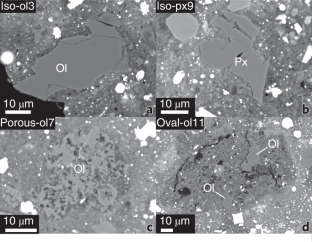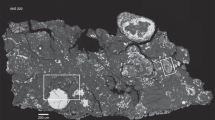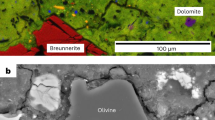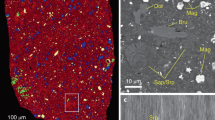Abstract
The abundant phyllosilicate and carbonate minerals characterizing most of the returned particles from asteroid Ryugu suggest a history of extensive aqueous alteration on its parent body, similar to the rare mineralogically altered, but chemically primitive, CI (Ivuna-type) chondrite meteorites. Particle C0009 differs mineralogically from other Ryugu particles examined so far by containing anhydrous silicates at a level of ~0.5 vol%, and thus can help shed light on the unaltered original materials that constituted Ryugu’s protolith. In situ oxygen isotope measurements of the most Mg-rich olivine and pyroxene in C0009 reveal two populations of Δ17O: −25‰ to −15‰ and −8‰ to −3‰. The former and the latter populations correlate well with silicate morphologies similar to those seen in amoeboid olivine aggregates and chondrule phenocrysts, respectively, both of which are abundant in less aqueously altered carbonaceous chondrites. This result also highlights the presence of olivine with Δ17O close to the solar value in either a CI chondrite or an asteroid with CI-chondrite characteristics, and provides strong evidence that amoeboid olivine aggregates and Mg-rich chondrules accreted into Ryugu’s protolith. Our data also raise the possibility that the protoliths of CI and other carbonaceous chondrites incorporated similar anhydrous silicates.
This is a preview of subscription content, access via your institution
Access options
Access Nature and 54 other Nature Portfolio journals
Get Nature+, our best-value online-access subscription
$29.99 / 30 days
cancel any time
Subscribe to this journal
Receive 12 digital issues and online access to articles
$119.00 per year
only $9.92 per issue
Buy this article
- Purchase on Springer Link
- Instant access to full article PDF
Prices may be subject to local taxes which are calculated during checkout


Similar content being viewed by others
Data availability
All analytical data related to this manuscript are provided in Tables 1 and 2 and Supplementary Table 1 and will be available via the JAXA Data ARchives and Transmission System (https://darts.isas.jaxa.jp) after a 1 yr proprietary period. Source data are provided with this paper.
References
Yada, T. et al. Preliminary analysis of the Hayabusa2 samples returned from C-type asteroid Ryugu. Nat. Astron. https://doi.org/10.1038/s41550-021-01550-6 (2021).
Pilorget, C. et al. First compositional analysis of Ryugu samples by the MicrOmega hyperspectral microscope. Nat. Astron. https://doi.org/10.1038/s41550-021-01549-z (2021).
Russell, S. S., Suttle, M. D. & King, A. J. Abundance and importance of petrological type 1 chondritic material. Meteorit. Planet. Sci. 57, 277–301 (2022).
Krot, A. N., Keil, K., Scott, E. R. D., Goodrich, C. A. & Weisberg, M. K. in Treatise on Geochemistry 2nd edn Vol. 1 (eds Holland, H. D. & Kurekian, K. K.) 1–63 (Elsevier, 2014).
Lodders, K. Solar System abundances and condensation temperatures of the elements. Astrophys. J. 591, 1220–1247 (2003).
King, A. J., Schofield, P. F., Howard, K. T. & Russell, S. S. Modal mineralogy of CI and CI-like chondrites by X-ray diffraction. Geochim. Cosmochim. Acta 165, 148–160 (2015).
Rowe, M. W., Clayton, R. N. & Mayeda, T. K. Oxygen isotopes in separated components of CI and CM meteorites. Geochim. Cosmochim. Acta 58, 5341–5347 (1994).
Arakawa, M. et al. An artificial impact on the asteroid (162173) Ryugu formed a crater in the gravity-dominated regime. Science 368, 67–71 (2020).
Ito, M. et al. A pristine record of outer Solar System materials from asteroid Ryugu’s returned sample. Nat. Astron. https://doi.org/10.1038/s41550-022-01745-5 (2022).
Bland, P. A., Cressey, G. & Menzies, O. N. Modal mineralogy of carbonaceous chondrites by X-ray diffraction and Mössbauer spectroscopy. Meteorit. Planet. Sci. 39, 3–16 (2004).
Alfing, J., Patzek, M. & Bischoff, A. Modal abundances of coarse-grained (>5 μm) components within CI-chondrites and their individual clasts – mixing of various lithologies on the CI parent body(ies). Geochemistry 79, 125532 (2019).
Leshin, L. A., Rubin, A. E. & McKeegan, K. D. The oxygen isotopic composition of olivine and pyroxene from CI chondrites. Geochim. Cosmochim. Acta 61, 835–845 (1997).
Piralla, M. et al. Primordial water and dust of the Solar System: insights from in situ oxygen measurements of CI chondrites. Geochim. Cosmochim. Acta 269, 451–464 (2020).
Endress, M. Mineralogische und Chemische Untersuchungen an CI-Chondriten: ein Modell zur Mineralogisch-Kosmochemischen Evolution der (s) CI-Mutterkörper (s) (Univ. Münster, 1994).
Young, E. D. & Russell, S. S. Oxygen reservoirs in the early solar nebula inferred from an Allende CAI. Science 282, 452–455 (1998).
Clayton, R. N., Onuma, N., Grossman, L. & Mayeda, T. K. Distribution of the pre-solar component in Allende and other carbonaceous chondrites. Earth Planet. Sci. Lett. 34, 209–224 (1977).
McKeegan, K. D. et al. The oxygen isotopic composition of the Sun inferred from captured solar wind. Science 332, 1528–1532 (2011).
Yurimoto, H. et al. Oxygen isotopes of chondritic components. Rev. Mineral. Geochem. 68, 141–186 (2008).
Scott, E. R. D. & Krot, A. N. in Treatise on Geochemistry 2nd edn Vol. 1 (eds Holland, H. D. & Kurekian, K. K.) 65–137 (Elsevier, 2014).
Liu, M.-C. et al. Isotopic records in CM hibonites: implications for timescales of mixing of isotope reservoirs in the solar nebula. Geochim. Cosmochim. Acta 73, 5051–5079 (2009).
Clayton, R. N. Solar System: self-shielding in the solar nebula. Nature 415, 860–861 (2002).
Lyons, J. R. & Young, E. D. CO self-shielding as the origin of oxygen isotope anomalies in the early solar nebula. Nature 435, 317–320 (2005).
Yurimoto, H. & Kuramoto, K. Molecular cloud origin for the oxygen isotope heterogeneity in the Solar System. Science 305, 1763–1766 (2004).
Tenner, T. J. et al. in Chondrules (eds Russell, S. S. et al.) 196–246 (Cambridge Univ. Press, 2018).
Chizmadia, L. J., Rubin, A. E. & Wasson, J. T. Mineralogy and petrology of amoeboid olivine inclusions in CO3 chondrites: relationship to parent-body aqueous alteration. Meteorit. Planet. Sci. 37, 1781–1796 (2002).
Imai, H. & Yurimoto, H. Oxygen isotopic distribution in an amoeboid olivine aggregate from the Allende CV chondrite. Geochim. Cosmochim. Acta 67, 765–772 (2003).
Mikouchi, T. et al. Olivine compositional variation of asteroid Ryugu samples: possible precursors of Ryugu’s parent asteroid. In 53rd Lunar and Planetary Science Conference, abstr. 1935 (2022).
Velbel, M. A., Tonui, E. K. & Zolensky, M. E. Replacement of olivine by serpentine in the carbonaceous chondrite Nogoya (CM2). Geochim. Cosmochim. Acta 87, 117–135 (2012).
Fujiya, W., Sugiura, N., Sano, Y. & Hiyagon, H. Mn–Cr ages of dolomites in CI chondrites and the Tagish Lake ungrouped carbonaceous chondrite. Earth Planet. Sci. Lett. 362, 130–142 (2013).
Krot, A. N. et al. Amoeboid olivine aggregates and related objects in carbonaceous chondrites: records of nebular and asteroid processes. Geochemistry 64, 185–239 (2004).
Ruzicka, A., Floss, C. & Hutson, M. Amoeboid olivine aggregates (AOAs) in the Efremovka, Leoville and Vigarano (CV3) chondrites:a record of condensate evolution in the solar nebula. Geochim. Cosmochim. Acta 79, 79–105 (2012).
Krot, A. N., McKeegan, K. D., Leshin, L. A., MacPherson, G. J. & Scott, E. R. D. Existence of an 16O-rich gaseous reservoir in the solar nebula. Science 295, 1051–1054 (2002).
Itoh, S., Russell, S. S. & Yurimoto, H. Oxygen and magnesium isotopic compositions of amoeboid olivine aggregates from the Semarkona LL3.0 chondrite. Meteorit. Planet. Sci. 42, 1241–1247 (2007).
Jacquet, E. & Marrocchi, Y. Chondrule heritage and thermal histories from trace element and oxygen isotope analyses of chondrules and amoeboid olivine aggregates. Meteorit. Planet. Sci. 52, 2672–2694 (2017).
Jilly-Rehak, C. E., Huss, G. R., Nagashima, K. & Schrader, D. L. Low-temperature aqueous alteration on the CR chondrite parent body: implications from in situ oxygen-isotope analyses. Geochim. Cosmochim. Acta 222, 230–252 (2018).
Vacher, L. G., Marrocchi, Y., Villeneuve, J., Verdier-Paoletti, M. J. & Gounelle, M. Petrographic and C & O isotopic characteristics of the earliest stages of aqueous alteration of CM chondrites. Geochim. Cosmochim. Acta 213, 271–290 (2017).
Ushikubo, T., Kimura, M., Kita, N. T. & Valley, J. W. Primordial oxygen isotope reservoirs of the solar nebula recorded in chondrules in Acfer 094 carbonaceous chondrite. Geochim. Cosmochim. Acta 90, 242–264 (2012).
Ushikubo, T. & Kimura, M. Oxygen-isotope systematics of chondrules and olivine fragments from Tagish Lake C2 chondrite: implications of chondrule-forming regions in protoplanetary disk. Geochim. Cosmochim. Acta 293, 328–343 (2021).
Kimura, M. et al. The most primitive CM chondrites, Asuka 12085, 12169, and 12236, of subtypes 3.0–2.8: their characteristic features and classification. Polar Sci. 26, 100565 (2020).
Rowe, M. W., Clayton, R. N. & Mayeda, T. K. Oxygen isotopes in separated components of CI and CM meteorites. Geochim. Cosmochim. Acta 58, 5341–5347 (1994).
Clayton, R. N. & Mayeda, T. K. The oxygen isotope record in Murchison and other carbonaceous chondrites. Earth Planet. Sci. Lett. 67, 151–161 (1984).
Young, E. D. et al. The oxygen isotopic composition of samples returned from asteroid Ryugu: evidence for similarity to CI chondrites. In 53rd Lunar and Planetary Science Conference, abstr. 1290 (2022).
Greenwood, R. C. et al. The oxygen isotopic composition of Hayabusa2 particles: testing the relationship with CI And CY chondrites. In 53rd Lunar and Planetary Science Conference, abstr. 2105 (2022).
Isa, J. et al. Quantification of oxygen isotope SIMS matrix effects in olivine samples: correlation with sputter rate. Chem. Geol. 458, 14–21 (2017).
Acknowledgements
We thank all of the scientists and engineers of the Hayabusa2 project, whose dedication and skill brought these precious particles back to Earth. This research was supported in part by the JSPS KAKENHI (under grant numbers JP18K18795 and JP18H04468 to M.I., JP20H01965 to N.T., JP18H05479 [Innovative Areas “MFS Materials Science”] to M.U., JP19H01959 to A.Y., JP18K03729 to M.K., JP21K03652 to N.I., JP17H06459 to T.U., JP19K03958 to M.A., JP17H06459 to T. Ohigashi, JP18K03830 to T.Y. and JP17H06459 and JP19H01951 to S.W.) and by the NIPR Research Project (grant number KP307 to A.Y.). K. McKeegan, E. Young and A. Brearley are thanked for discussions of the implications of the data. The UCLA ion microprobe facility is partially supported by a grant from the NSF Instrumentation and Facilities programme.
Author information
Authors and Affiliations
Contributions
M.-C.L. led the project and wrote the initial draft. M-C.L., A.Y., N.T., M.I., M.U., T. Ohigashi., N.I., N.S., A.N., Y. Kodama, K.A.M., N.M. and K.Y. conducted the sample handling, preparation and mounting processes for the Ryugu grains. M.I., N.T., M.U., T. Ohigashi., K.U., K.H., I.S. and I.O. developed universal sample holders for multiple instruments. A.Y., M.K., N.I. and M.I. performed the scanning electron microscopy–energy dispersive spectroscopy analysis. A.Y. conducted the EPMA analysis and data reduction. M.-C.L., K.A.M. and N.M. carried out the oxygen isotope measurements of anhydrous silicates with secondary-ion mass spectrometry. A.N., K.Y., A.M., M.N., T.Y., T. Okada., M.A. and T.U led the JAXA curation activities for the initial characterization of the allocated Ryugu particles. S.N., T. Okada., T.S., S.T., F.T., M.Y., S.W. and Y.T. administered the project and acted as principal investigators. All authors contributed to the data interpretation, commented on the earlier versions of the manuscript and approved the final version of the manuscript for submission.
Corresponding author
Ethics declarations
Competing interests
The authors declare no competing interests.
Peer review
Peer review information
Nature Astronomy thanks Enrica Bonato, Luigi Folco and the other, anonymous, reviewer(s) for their contribution to the peer review of this work.
Additional information
Publisher’s note Springer Nature remains neutral with regard to jurisdictional claims in published maps and institutional affiliations.
Extended data
Extended Data Fig. 1 Backscattered electron images of all anhydrous silicates measured in this work.
Backscattered electron images of all anhydrous silicates, which are categorized according to their morphology, measured in this work.
Supplementary information
Supplementary Information
Supplementary Text, Figs. 1 and 2 and Table 1.
Source data
Source Data Fig. 2
Processed oxygen isotope data of Ryugu anhydrous silicates (this study) and oxygen isotope data of CI-chondrite anhydrous silicates from the literature.
Rights and permissions
Springer Nature or its licensor holds exclusive rights to this article under a publishing agreement with the author(s) or other rightsholder(s); author self-archiving of the accepted manuscript version of this article is solely governed by the terms of such publishing agreement and applicable law.
About this article
Cite this article
Liu, MC., McCain, K.A., Matsuda, N. et al. Incorporation of 16O-rich anhydrous silicates in the protolith of highly hydrated asteroid Ryugu. Nat Astron 6, 1172–1177 (2022). https://doi.org/10.1038/s41550-022-01762-4
Received:
Accepted:
Published:
Issue Date:
DOI: https://doi.org/10.1038/s41550-022-01762-4
This article is cited by
-
Early fluid activity on Ryugu inferred by isotopic analyses of carbonates and magnetite
Nature Astronomy (2023)
-
Chondrule-like objects and Ca-Al-rich inclusions in Ryugu may potentially be the oldest Solar System materials
Nature Communications (2023)
-
A history of mild shocks experienced by the regolith particles on hydrated asteroid Ryugu
Nature Astronomy (2023)
-
Insight into multi-step geological evolution of C-type asteroids from Ryugu particles
Nature Astronomy (2023)
-
Oxygen isotope evidence from Ryugu samples for early water delivery to Earth by CI chondrites
Nature Astronomy (2022)



